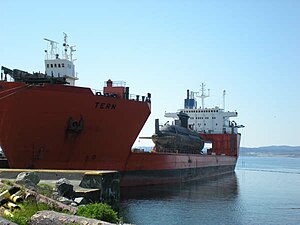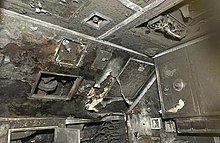HMCS Chicoutimi (SSK 879)

| |
| History | |
|---|---|
| Name | HMS Upholder |
| Builder | VSEL, Barrow-in-Furness |
| Laid down | February 1986 |
| Launched | 2 December 1986 |
| Commissioned | 7 December 1990 |
| Decommissioned | 29 April 1994 |
| Fate | Transferred to Canada |
| Badge |  |
| History | |
| Name | HMCS Chicoutimi |
| Acquired | 1998 |
| Commissioned | October 2004 |
| Motto | MAÎTRE DU DOMAINE |
| Honors and awards | Atlantic, 1941-44. |
| Status | in active service - awaiting repair (Dry-docked) |
| Badge |  |
| General characteristics | |
| Class and type | Upholder/Victoria-class submarine |
| Displacement | list error: <br /> list (help) 2,260 long tons (2,296 t) surfaced 2,500 long tons (2,540 t) submerged |
| Length | 230 ft 7 in (70.28 m) |
| Beam | 23 ft 7 in (7.19 m) |
| Draught | 24 ft 11 in (7.59 m) |
| Speed | list error: <br /> list (help) 12 knots (14 mph; 22 km/h) surfaced 20 kn (23 mph; 37 km/h) submerged |
| Complement | 48 officers and crew, plus 7 trainees |
| Armament | list error: <br /> list (help) • 6 × 21 in (530 mm) torpedo tubes • 18 × Mark 48 torpedoes |
HMCS Chicoutimi is a Victoria-class long-range hunter-killer (SSK) submarine of the Canadian Navy, originally built and operated by the Royal Navy as HMS Upholder. Shortly after being handed over from the UK to Canada she was involved in a partial flooding incident which resulted in a fire at sea. The incident sparked a fierce debate over the value of the purchase of this group of second-hand vessels, as well as the handover inspection process. Despite all the media speculation, this was later proven to be as a result of an error in operational procedure.[1]
Construction
This submarine was built for the Royal Navy as HMS Upholder (S40), the lead ship of the Upholder (2400) class of submarines, named after the original Upholder. She was laid down by Vickers Shipbuilding and Engineering Ltd (VSEL) in February 1986, launched on 2 December 1986, and commissioned into the Royal Navy on 7 December 1990.[2] Her commissioning was delayed because of a potential problem with the operation of the torpedo tubes.
Operational history
This section needs expansion. You can help by adding to it. (May 2010) |
Following the end of the Cold-War and subsequent cancellation of the programme, along with the other three vessels in the class, she was decommissioned on 29 April 1994,[2] amidst some controversy, as a financial measure.
Looking to discontinue the operation of diesel-electric boats, the British government offered to sell Upholder and her sister submarines to Canada in 1993.[3] The offer was accepted in 1998.[3] The four boats were leased to the Canadians for US$427 million (plus US$98 million for upgrades and alteration to Canadian standards), with the lease to run for eight years; after this, the submarines would be sold for £1.[2]
Problems were discovered with the piping welds on all four submarines, which delayed the reactivation of Upholder and her three sisters.[2] Upholder was the last to be restored, and when work commenced on the submarine, internal steelwork was found to be corroded, hull valves were cracked, air turbine pumps were defective, and equipment was missing (although it was later determined that this equipment had been taken to refit sister boat HMCS Corner Brook (the former HMS Ursula)).[4]
Upholder was commissioned as HMCS Chicoutimi (named for the city of Chicoutimi, Quebec, now a borough of the city of Saguenay).[2]
Fire

Chicoutimi was the last of the newly renamed Victoria-class vessels to be completed, and was handed over to the Canadians on 2 October 2004 at Faslane Naval Base. Two days later, Chicoutimi set sail for her new home port at CFB Halifax in Nova Scotia.
On 5 October, Chicoutimi was apparently surfaced and running through heavy seas 100 miles (160 km) north-west of County Mayo, Ireland. Both hatches in the bridge fin lockout chamber were left open and an estimated 2,000 litres of seawater entered the vessel. The seawater caused an electical panel to short out, which in turn started a major fire and caused all power to cut out, leaving the submarine adrift.[2] Nine crewmembers were affected by smoke inhalation and the ship was left drifting without power in heavy seas.[5] Three of these crew members were airlifted to Sligo General Hospital in the Republic of Ireland the next day, with one listed in 'critical' condition. Later, on 6 October, Canadian Prime Minister Paul Martin confirmed that one of the Chicoutimi's crew, Lieutenant(N) Chris Saunders, died in transit to hospital.[6]
The RNLI lifeboat stationed on Achill Island, County Mayo (the "Sam and Ada Moody") was put on standby to assist, but was later stood down. An Irish Naval Service vessel, the LÉ Róisín, attempted to assist the submarine, but was seriously damaged by the rough seas and forced to return to harbour. The only other Irish naval vessels available to help, the LÉ Aoife and LÉ Niamh were patrolling off Ireland's southern coast. At 2 p.m. local time, the Royal Navy frigate HMS Montrose and the auxiliary vessel RFA Wave Knight reached the crippled Chicoutimi, with an additional three British ships en route. The LÉ Aoife later reached the area, and took over co-ordination of the rescue and salvage efforts. Other ships dispatched to assist the boat were HMS Marlborough and RFA Argus, as well as a number of specialist vessels to handle the situation. The rough conditions in the North Atlantic were impeding the efforts of the Irish and British navies to rescue the surfaced Chicoutimi, and a former Canadian naval officer said of the Chicoutimi that "[it's] not [a] good surface rider at all. It’s by no means unsafe; it’s just very uncomfortable."[7]
By the evening of 7 October, the weather had abated, and the Chicoutimi was taken in tow by the British Coastguard tugboat Anglian Prince to return to Faslane Naval Base in Scotland. Towing was later taken over by the United States Submarine Support Vessel MV Carolyn Chouest, which was able to increase the towing speed from three knots (6 km/h) to eight or nine knots (15 or 17 km/h), and reached Faslane on the evening of 10 October. Chicoutimi was escorted into the Royal Navy base by HMCS St. John's, a Canadian frigate which rushed across the Atlantic after the navy learned of the fire.
Following claims made in the Canadian media about the cause of the fire, blaming the UK for supplying an unsafe vessel, the situation was further exacerbated by controversial comments made by Secretary of State for Defence Geoff Hoon. He accompanied his condolences for Saunders with a proposal that the Royal Navy would charge Canada for the cost of the rescue while also stating that Canada as the buyer had to beware. In Canada, many World War II veterans were outraged by his comments, considering Canada's sacrifice for the British.[1] As well as highlighting the problems with the Victoria class, the incident also sparked debate in Ireland over the country's search and rescue capabilities.[citation needed]

After some repairs were made at Faslane, Chicoutimi was loaded onto a heavy lift ship and transported to Halifax, where she was drydocked for further work.[2] In April 2006, it was announced that repair priorities had shifted; Chicoutimi would remain in drydock until at least 2010, and would likely not be seaworthy again until 2012.[8]
Heraldry

HMS Upholder (S40)
The precursor of the Upholder (S40) was the Upholder (P37). In 1941 the Upholder (P37) was granted a badge which contained a caryatid. The ship's captain, lieutenant commander Wanklyn, described the badge as "an armless Greek bint standing in a dustbin"; and designed his own unofficial badge for the ship. The Upholder (S40) originally sailed under the original Upholder's official badge, yet was allowed to sail under the badge designed by Wanklyn.[9]
HMCS Chicoutimi (SSK 879)
The badge of the Chicoutimi is blazoned:
Azure in front of a pile argent bordered throughout by a letter "V" also argent fimbriated azure surmounting three bars wavy in base argent a bear rampant sable holding in the forepaws a fleur-de-lis azure.[10]
The badge's blue and white "V" is in reference to the Victoria class submarines and the colours of Quebec. The bear represents the bears which are indigenous to the Chicoutimi area. The bear protects a fleur-de-lis and stands upon waves; representing the lakes in rivers in the Chicoutimi as well as the maritime environment in which the submarine operates.[10]
The colours of the Chicoutimi are blue and white. The motto of the Chicoutimi is MAÎTRE DU DOMAINE, which translates into English as "master of the domain".[11]
See also
References
- ^ a b HMCS Chicoutimi Board of Enquiry website
- ^ a b c d e f g Wertheim, Eric, ed. (2007). The Naval Institute Guide to Combat Fleets of the World: Their Ships, Aircraft, and Systems (15th ed.). Annapolis, MD: Naval Institute Press. pp. 77–8. ISBN 9781591149552. OCLC 140283156.
- ^ a b Ferguson, Julie H. (2000). Deeply Canadian: New Submarines for a New Millennium. Beacon Publishing. p. 152. ISBN 096898570X.
- ^ Halifax Daily News: Fourth sub delayed by rust :: PEJ News :: Stories, Features, Opinion and Analysis :: Peace, Earth & Justice News
- ^ "Nine hurt on stricken submarine". BBC News. 6 October 2004. Retrieved 4 May 2010.
- ^ Canadian sailor dies in submarine accident
- ^ http://www.hfxnews.com/news.aspx?pname=News&StoryID=22491
- ^ Fire-damaged sub won't be operational until 2012
- ^ "Barrow Built Upholder Class, 1990 - 1994". www.submariners.co.uk. Retrieved October 11, 2009.
- ^ a b "Volume 2, Part 1: Extant Commissioned Ships". Chief Military Personnel. Retrieved October 11, 2009.
{{cite web}}: External link in|work= - ^ "HMCS Chicoutimi" (pdf). Chief Military Personnel. 15 September 2005. Retrieved October 11, 2009.
{{cite web}}: External link in|work=
